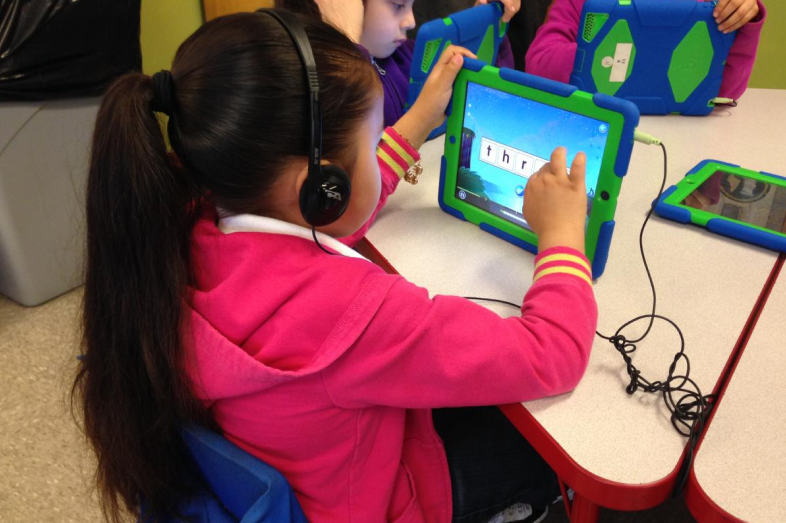

Laptops chimed as students played a game designed to teach them the basics of geometry inside a fourth grade classroom at the Cesar E. Chavez Multicultural Academic Center on the south side of Chicago. Large paper mobiles of various geometric shapes hung from the ceiling and a list of classroom jobs for each student was posted on the wall.
The blended learning campus, where 80 percent of its nearly 1,000 students are English language learners, stands apart from the traditional school structure because it does not separate students learning English from other students for some or all of the academic day, and because of its technology-infused instruction. It also offers an extended school day. (Blended learning refers to a mix of traditional live classroom interaction and online technology to guide instruction.)
But it wasn’t always like this.
Before the blended learning model was implemented in November 2010, English language learners were taught in separate classrooms from their peers.
Reporters participating in the Education Writers Association’s recent National Seminar in Chicago had an opportunity to visit Chavez in April. The campus began using the blended learning model in 2010 through a Chicago Public Schools’ Additional Learning Opportunities program. When that funding ended, school officials went looking for community support, said Joseph Rosen, an assistant principal on the campus.
Extra financial support a variety of sources, including LEAP Innovations, an educational technology nonprofit hub focusing on school redesign in the Windy City. The campus went from being ranked No. 268 to No. 8 from 2009 to 2014, according to a Chicago Public Schools Performance Policy and School Ranking report.
Under the blended learning model and the extended learning day, the Cesar E. Chavez campus has been rated as one of the Chicago district’s top elementary school campuses for the last four years.
The school’s challenges are significant, with nearly 100 percent of students receive free or reduced-price lunch. The campus also has a student mobility rate of 14 percent.
The school’s programs don’t end with blended learning. It also offers an extra hour a day four days a week, as well as community programs for parents, and student-centered learning.
Teachers are paid through a Chicago Public Schools pilot program to provide the extra lessons Monday through Thursday, Rosen said.
The day can go on even longer, with classes like yoga and Zumba for parents after school, while their kids attend tutoring sessions. Professionals contribute to the sense of community by volunteering to read to and mentor Chavez students.
When reporters visited a kindergarten classroom in April, students sat at different tables, four to five at each, with head phones connected to iPads, and at another table practicing their handwriting and coloring in worksheets. A teacher in the corner of the room helped students sound out and pronounce words in English. A parent volunteer helped the teacher out by sorting through worksheets on the other side of the room.
In a first grade classroom, a student paced around a table listening to a group of students taking turns reading through a passage. The students kept each other on task through a classroom structure that, “empowers students to take control of their own learning,” Rosen said.
In a third grade classroom, students pulled out books to read with each other on the carpet. On the other side of the room, students were taking reading exams on computers with their headphones on.
Images of Cesar E. Chavez, a Mexican-American labor rights activist, were posted on the walls of the school, alongside quotes by Chavez within the kindergarten classroom.
The campus has a 96 percent student attendance rate. To help keep that rate high, students can earn points for incentives, and they are expected to keep track of their own attendance to encourage personal accountability.
The incentives vary by grade level, said Principal Dassinger. Rather than offer food rewards (which can run afoul of the district’s health and nutrition policy) the school focuses on special field trips, extra recess breaks and arts and crafts parties.
After nine or more absences, students are required to attend summer school.
Middle school students are required to apply to several area high schools and are taken on field trips to tour high school campuses.